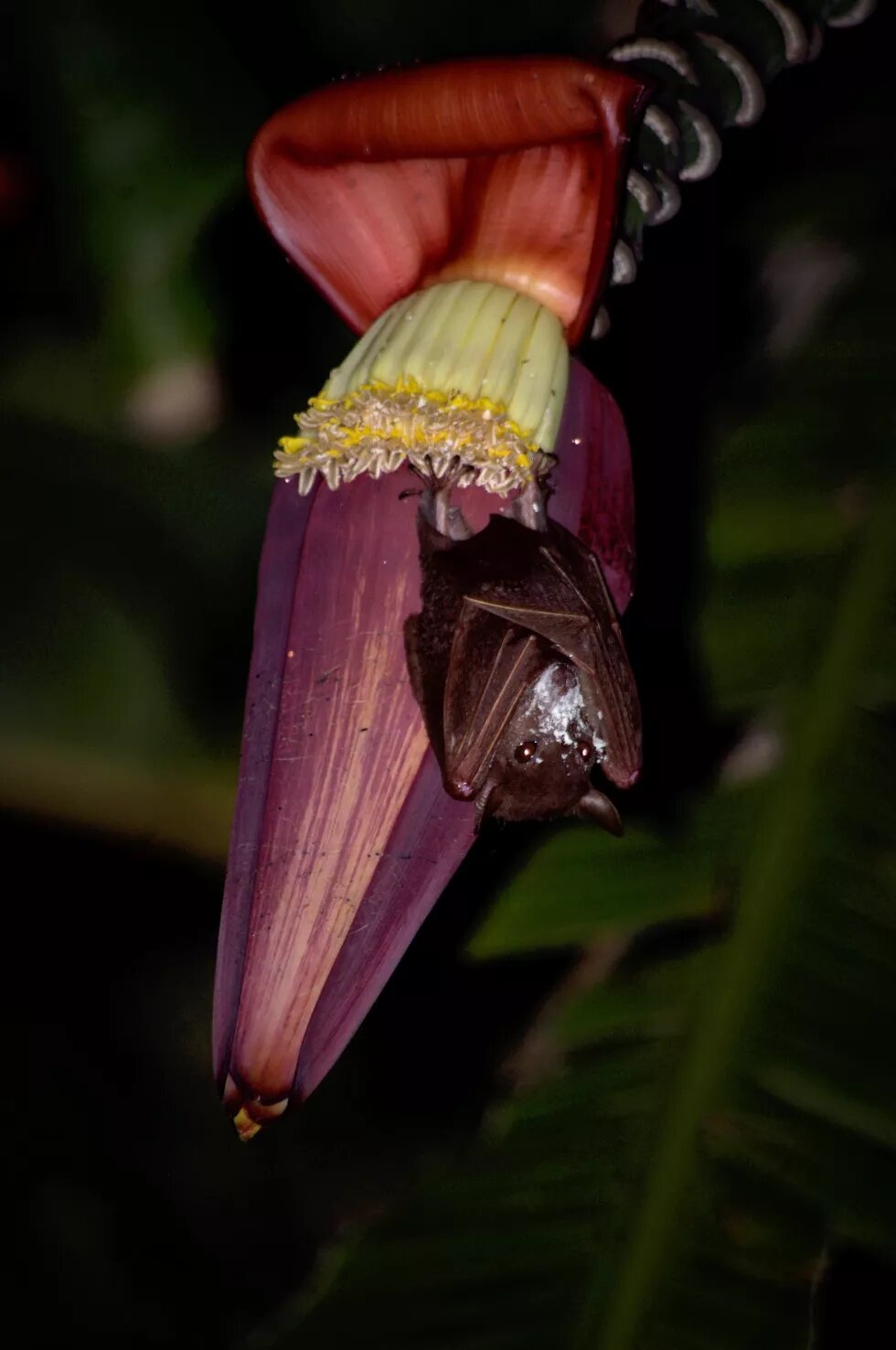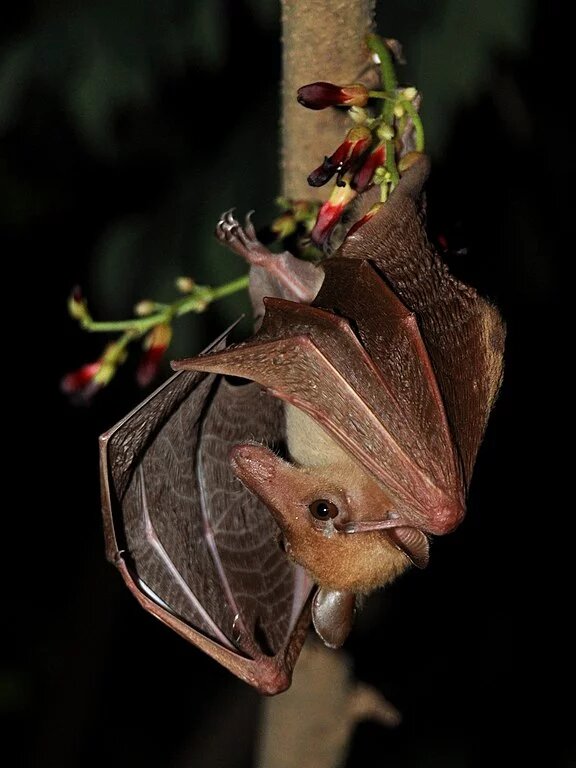
Animal pollinators, including bats, play a crucial role in the reproduction of flowering plants. Learn how these often misunderstood creatures contribute to genetic diversity, ecosystem health, and our global economy. This article explores the challenges they face in the face of habitat loss and degradation, and to find out how you can help protect these essential pollinators.

Animal pollinators are critically important for most flowering plant species. In fact, an estimated 87% of flowering plant species worldwide depend on animal pollinators for reproduction (Ollerton et al. 2011). Pollinators are important not only for enabling plants to produce fruits and seeds, but also for influencing genetic diversity and gene flow within and across plant populations. Thus, pollinators are a necessary component of ecosystem functioning across diverse habitats. Animals also assist in pollinating many plants that are important to humans, including crops and medicinal plants. The economic value of insect pollination has been estimated to exceed €153 billion per year (Gallai et al. 2009).
Most attention towards pollinators has focused on bees and other insects. However, many species of birds and mammals are also pollinators. Of the mammal pollinators, the most common and important are bats, which pollinate an estimated 500 plant species (Fenton & Simmons 2015). In fact, recent research shows that vertebrate-pollinated plants (such as those pollinated by birds and mammals) tend to be more dependent on their pollinators than insect-pollinated plants, and this is particularly true for bat-pollinated plants (Ratto et al. 2018).
Bats pollinate a number of economically important plant species, including agave, durian, and eucalyptus (Fleming et al. 2009). They also pollinate numerous ecologically important plant species, such as some species of mangroves, wild bananas, and cacti (Fleming et al. 2009). Thus, while bats are often the focus of negative attention, particularly in recent years with the spread of zoonotic diseases such as COVID-19, they are incredibly important to diverse plant species, and humans benefit greatly from their pollination services.
Bat pollination is only found in tropical regions, where flowers are available year-round. Flower-visiting bats in the Old World tropics (tropical areas of Asia, Africa, and Australia) belong to the family Pteropodidae, which includes flying foxes, while those in the New World tropics (tropical areas of Central and South America) belong to the family Phyllostomidae. Several key differences distinguish the two groups. One major difference is that phyllostomids can echolocate, like other bat species, while pteropodids possess only primitive echolocation and rely primarily on vision and smell to navigate and forage.
Another difference is that phyllostomids are typically much smaller and are capable of hovering flight, while pteropodids are often much larger and must land on flowers during foraging (Fleming & Muchhala 2008). Thus, bat-pollinated flowers in the Old World are often much larger and sturdier than bat-pollinated flowers in the New World.
Studying bat pollination is particularly difficult given that bats are active at night, can fly fast and far, and often forage high above our heads. Researchers therefore rely on different methods to learn more about bat-plant pollination interactions. One method is to use night vision cameras with infrared lights. Another option is to use acoustic bat detectors, although this method is less effective in environments with dense vegetation that block echolocatory calls and does not work at all for non-echolocating pteropodid bats. Some studies have collected fecal samples from under bat roosts, and used microscopes to identify the pollen grains in order to discover which flower species were visited.
These days, recent advances in molecular techniques allow us to study plant-pollinator interactions via DNA (e.g., to identify the pollen grains collected from bat fur or fecal samples, or to identify the pollinators that have deposited trace amounts of DNA on flowers). Perhaps the most widespread method is using specially designed nets (mist-nets) to catch bats during foraging. By catching bats, researchers can identify individuals to species, as well as collect different types of samples and record information about size, sex, age, etc.
I first started mist-netting bats in southern Thailand in 2011 as part of my PhD research and, with the help of many colleagues and students, have continued collecting data for over a decade. I initially started mist-netting bats from a desire to know which bat species pollinate which plant species. Short answer: the cave nectar bat (Eonycteris spelaea) is the main pollinator for many night-blooming species (including durian, petai, and kapok), while the greater long-tongued nectar bat (Macroglossus sobrinus) is the main pollinator for wild bananas and the lesser long-tongued nectar bat (Macroglossus minimus) is the main pollinator for Sonneratia mangroves (Stewart & Dudash 2017).
However, as I continued to mist-net bats over the past decade, I became curious about how these bats are handling the extensive changes in land-use that have occurred in southern Thailand, and that are also occurring throughout all of Southeast Asia. Research shows that southern Thailand lost 21% of terrestrial forests, 26% of mangrove forests, and 55% of peat swamp forests between 1995 and 2015, with up to 33% of remaining forests classified as highly vulnerable to future land conversion (Tantipisanuh & Gale, 2022).
In the face of such extensive deforestation, we therefore looked at our mist-net capture rates between 2011 and 2021. Our data indicate that bat species are responding differently to such anthropogenic change. On the one hand, the cave nectar bat (E. spelaea) appears to be relatively unaffected, as mist-netting rates have been consistent over the past decade. However, we have observed an 80% declines in the mist-netting rates of both species of long-tongued nectar bats (M. sobrinus and M. minimus). Such results are highly troubling, and support the estimation that at least 23% of the bat species in Southeast Asia will be extinct by 2100 (Lane et al., 2006).
Why such dramatic differences between the cave nectar bat and the long-tongued nectar bats? There may be several factors contributing to how these bats are responding to anthropogenic changes in land use. For example, the cave nectar bat roosts in caves while the long-tongued nectar bats roost in vegetation. Therefore, foliage-roosting bats may be more directly impacted by deforestation than cave-roosting bats. Another difference between them is that the cave nectar bat is much larger (45-75 g) than the long-tongued nectar bats (11-29 g). Because of their larger size, cave nectar bats can fly much farther during foraging than smaller bats.
Finally, the cave nectar bat has a broad diet and visits the flowers of many plant species that are intentionally cultivated by humans (e.g., durian, petai, kapok, banana, and Indian trumpet flower), so they may actually benefit from increased floral resources in certain areas. In contrast, the long-tongued nectar bats typically forage on just one or two plant species, and may therefore be more impacted by habitat loss and degradation.
Land conversion is having negative impacts on many species, and bats are no exception. The 80% decline that we observed for the long-tongued nectar bats over the past decade is troubling not only for the bats themselves, but also for the plant species they pollinate. The loss of pollinators not only reduces plant reproduction, but it also reduces gene flow between and within plant populations, which can lead to low genetic diversity.
The mutualism between M. minimus bats and Sonneratia mangroves is especially at risk given that (1) some species of Sonneratia are already critically endangered or near threatened, (2) southern Thailand has already lost most of its mangroves, and (3) M. minimus bats are known to roost in mangroves, which means that they are losing critical roosting habitat in addition to their preferred food resources.
How can we help bat pollinators? Perhaps the most critical step is halting habitat loss and degradation. Forests are obviously a critical habitat for many bat species, providing diverse food resources and, for many species, roosting locations as well. Caves are another important habitat for many bats, such as the cave nectar bat. Current threats to caves include mining (especially mining karsts for limestone needed to make cement, and mining guano for fertilizer) and human tourism and recreation, which can disturb bats and thus reduce the number of suitable roosts.
Hunting bats for bushmeat is another threat in many areas of Southeast Asia, particularly for larger species such as flying foxes and cave nectar bats. Other current global issues, such as climate change and pollution, likely impact bat pollinators as well. Finally, increased awareness about the ecosystem services that bats provide (not just pollination, but also pest control, seed dispersal, and more) can go a long way towards changing negative attitudes and raising public interest in protecting these important species.
__
Alyssa B. Stewart is Associate Professor at the Department of Plant Science, Mahidol University, Thailand. Her main research area covers pollination ecology, plant-animal interactions, bees, nectar bats, biodiversity and conservation.
The views expressed in this article are not necessarily those of Heinrich Böll Stiftung.
References
Fenton MB, Simmons NB. Bats: a world of science and mystery. University of Chicago Press; 2020.
Fleming TH, Geiselman C, Kress WJ. The evolution of bat pollination: a phylogenetic perspective. Annals of Botany. 2009;104(6):1017-43.
Fleming TH, Muchhala N. Nectar‐feeding bird and bat niches in two worlds: pantropical comparisons of vertebrate pollination systems. Journal of Biogeography. 2008;35(5):764-80.
Gallai N, Salles JM, Settele J, Vaissière BE. Economic valuation of the vulnerability of world agriculture confronted with pollinator decline. Ecological Economics. 2009 Jan 15;68(3):810-21.
Lane DJ, Kingston T, Lee BP. Dramatic decline in bat species richness in Singapore, with implications for Southeast Asia. Biological Conservation. 2006;131(4):584-93.
Ollerton J, Winfree R, Tarrant S. How many flowering plants are pollinated by animals? Oikos. 2011;120(3):321-326.
Ratto F, Simmons BI, Spake R, Zamora-Gutierrez V, MacDonald MA, Merriman JC, et al. Global importance of vertebrate pollinators for plant reproductive success: a meta-analysis. Frontiers in Ecology and the Environment. 2018;16(2):82–90.
Stewart AB, Dudash MR. Flower-visiting bat species contribute unequally toward agricultural pollination ecosystem services in southern Thailand. Biotropica. 2017;49(2):239–48.
Tantipisanuh N, Gale GA. Identification of areas highly vulnerable to land conversion: A case study from southern Thailand. Environ Manage. 2022;69(2):323–32.



